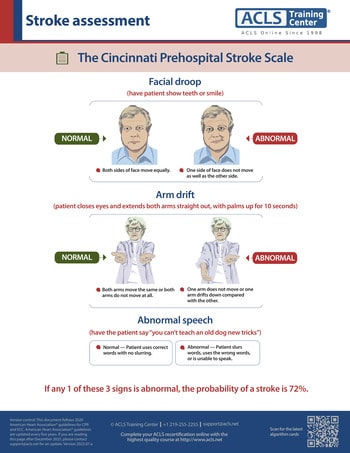
Version control: Our ACLS, PALS & BLS courses follow 2020 American Heart Association Guidelines for CPR and ECC. American Heart Association guidelines are updated every five years. If you are reading this page after December 2025, please contact support@ACLS.net for an update. Version 2021.01.c
To test for stroke probability, instruct the patient to show their teeth or smile. Evaluate for facial droop. It is abnormal if one side of the face does not move as well as the other. Next, evaluate arm drift. Instruct the patient to close their eyes and extend both arms straight out, with the palms up for 10 seconds. It is abnormal if one arm does not move or one arm drifts down compared with the other. Third, evaluate for abnormal speech. Have the patient say “you can’t teach an old dog new tricks.” It is abnormal if the patient slurs words, uses the wrong words, or is unable to speak. If any one of the 3 signs is abnormal, the probability of a stroke is 72%.

Order the full set of printed crash cart cards
Identify signs and symptoms of a possible stroke and activate the emergency response system.
Pre-hospital interventions by EMS will focus on supporting ABCs and giving oxygen if indicated, performing a prehospital stroke assessment using an approved tool such as the Cincinnati Stroke Scale, checking glucose, establishing time of symptom onset (or last seen normal), triaging to a stroke center, and alerting the hospital to activate the stroke team.
Within 10 minutes of ED arrival perform immediate general assessment within 10 minutes of patient arrival to the ED and stabilize ABCs if necessary. Provide oxygen therapy if hypoxic. Obtain IV access and perform laboratory assessments.
Check glucose and treat if indicated. Obtain a 12-lead ECG and perform neurologic screening assessment. Do not delay CT, obtain CT without contrast within 20 minutes of patient arrival.
A neurologic assessment by the stroke team or designee should be done within 20 minutes of patient arrival to the ED. Review patient history, establish the time of symptom onset or last known normal, and perform a neurological examination using a standardized tool such as the NIH Stroke Scan or Canadian Neurological Scale.
If the CT scan shows hemorrhage, consult a neurologist or neurosurgeon and consider a transfer. Begin stroke or hemorrhage pathway. Admit to a stroke unit or intensive care.
If the CT scan shows no hemorrhage, consider fibrinolytic therapy. Check the fibrinolytic exclusions, repeat the neurologic exam to determine if symptoms are improving or worsening.
Candidates with the onset of symptoms within 3 hours or 4.5 hours in selected patients are eligible.
If the patient is a candidate for rTPA review the risks and benefits with the patient and family. Begin fibrinolytic therapy within 60 minutes of patient arrival to the ED. Consider endovascular therapy for the onset of symptoms up to 24 hours and large vessel occlusion. Admit the patient to stroke care within 3 hours of arrival to the ED.
Begin post-rTPA stroke care. Monitor blood pressure and neurological symptoms. Monitor for adverse reactions to fibrinolytic therapy.